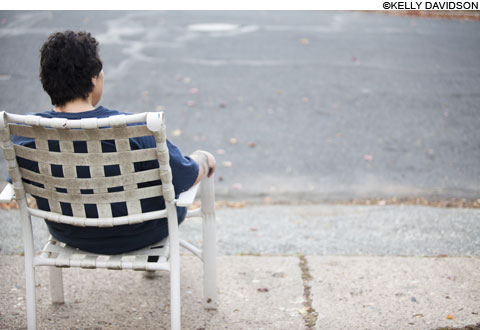
MAD SKILLS Diagnosed as a schizophrenic, Marty is a facilitator for a support group where people who hear voices help each other cope. |
HOLYOKE — She can hear a baby crying.She searches the house, each cluttered room, the closets, under the bed. She checks the cupboards. She checks behind the shower curtains.
There is no baby.
She can still hear it wailing.
***
She has renamed herself Marty. She hopes it might help her pull things together. The voices say she's worthless. She tries not to listen.
Here she is in daylight: her hair short, her legs unshaven, her eyes the dark eyes of a Byzantine saint. Her skin is covered in tattoos, some homemade, and covered also in scars: thin white lines, especially on her left arm and on her chest, a fine crosshatching like the lines in an old engraving. When she starts a new job — she works as a personal care assistant for the elderly and disabled — she wears long sleeves, until she feels that her employers know her and trust her. Only then will she let them see her arms, the visible record of her pain.
There are scars on her mouth, too; older ones.
Marty is 52. She has been homeless and spent time in psych wards. She has been diagnosed with major depressive disorder, schizoaffective disorder, post-traumatic stress disorder, and psychotic disorder "not otherwise specified," which means she hears voices and no one knows why. She has been prescribed Prozac, Thorazine, lithium, Risperdal, Haldol, Lopax. She has also raised children, and gotten her BA. She was only recently discharged from a voluntary stay at the psych ward at Holyoke Medical Center. She's struggling with side-effects from her current meds.
From the house she shares with her grown daughter, it's a mile and a half to downtown Holyoke. She passes bars, liquor stores, young drug dealers and their clients. Mamas strolling babies, men selling bootleg DVDs. The Western Mass. Recovery Learning Center, a mental-health wellness collective, is on the third floor of one of Holyoke's dilapidated but still beautiful brick buildings.
The group meets in the library. It's like a big living room, lit by a few lamps, the walls lined with books. There are three overstuffed sofas, a TV, and a coffee table. When Marty started coming here, she sat in the rocking recliner in the corner, content to be silent but not alone.
Now she takes the seat on the couch furthest from the door, where she can make eye contact with everyone in the group. These are the people she has come to trust — who have, perhaps more importantly, come to trust her.
"Welcome," she says, "to the Hearing Voices group."
***
What does it mean to hear a voice when no one is there?
It is a very old question, and a terrifying one. Voice hearing, as a phenomenon, is scary — for the voice hearer but also for everyone else. It's so scary that we joke about it — I DO WHAT THE VOICES IN MY HEAD TELL ME is emblazoned on T-shirts — and we associate voice hearing with violence.